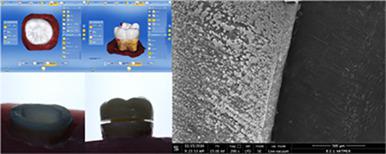当前位置:
X-MOL 学术
›
Microsc. Res. Tech.
›
论文详情
Our official English website, www.x-mol.net, welcomes your feedback! (Note: you will need to create a separate account there.)
Marginal adaptation and fracture strength of endocrowns manufactured with different restorative materials: SEM and mechanical evaluation.
Microscopy Research and Technique ( IF 2.5 ) Pub Date : 2020-09-11 , DOI: 10.1002/jemt.23586 Gaye Sağlam 1 , Seda Cengiz 1 , Özgül Karacaer 2
Microscopy Research and Technique ( IF 2.5 ) Pub Date : 2020-09-11 , DOI: 10.1002/jemt.23586 Gaye Sağlam 1 , Seda Cengiz 1 , Özgül Karacaer 2
Affiliation

|
Endocrowns were manufactured using different restorative materials to evaluate the marginal adaptation and fracture strength. Fifty endodontically treated mandibular first molar teeth were divided into five groups (n = 10). Endocrowns were obtained from lithium disilicate glass ceramic ingots by heat‐press technique (Group e.max Press: GEP), and from feldspathic blocks (Group Cerec: GC), polymer infiltrated ceramic network blocks (Group Enamic: GE), lithium disilicate glass ceramic blocks (Group e.max CAD: GEC), and zirconia‐reinforced glass ceramic blocks (Group Suprinity: GS) by CAD/CAM technique. After thermocycling, marginal adaptation was evaluated under scanning electron microscope at ×200 magnification. The specimens' fracture strengths were tested in universal test machine, and fracture types were evaluated. Statistical analyses were performed with Kruskal–Wallis test. The highest marginal gap value was found in GEP, but no significant differences were determined among the other four groups (p > .05). Significant differences were observed among the groups in terms of fracture strength (p = .019). The fracture strength values of GEC were significantly higher than GE, GC, and GS (p < .05). Values were not significantly different between the GEC and GEP groups (p > .05). CAD/CAM endocrowns showed better marginal adaptation than heat‐pressed endocrowns. Clinically acceptable marginal gaps were seen in both endocrown types. Both CAD/CAM and heat‐pressed lithium disilicate glass ceramic endocrowns showed higher fracture strength.
中文翻译:

用不同修复材料制造的内冠的边缘适应性和断裂强度:SEM 和机械评估。
使用不同的修复材料制造内冠以评估边缘适应性和断裂强度。将 50 颗经牙髓治疗的下颌第一磨牙分为 5 组(n= 10)。通过热压技术从二硅酸锂玻璃陶瓷锭(e.max Press:GEP)和长石块(Cerec 组:GC)、聚合物渗透陶瓷网络块(Enamic 组:GE)、二硅酸锂玻璃获得内冠陶瓷块(e.max CAD 组:GEC)和氧化锆增强玻璃陶瓷块(Suprinity 组:GS)通过 CAD/CAM 技术。热循环后,在×200 放大倍数的扫描电子显微镜下评估边缘适应。在万能试验机上测试试样的断裂强度,并对断裂类型进行评价。使用 Kruskal-Wallis 检验进行统计分析。GEP 的边际差距值最高,但其他四组之间没有显着差异(p > .05)。在断裂强度方面观察到各组之间存在显着差异 ( p = .019)。GEC 的断裂强度值显着高于 GE、GC 和 GS ( p < .05)。GEC 和 GEP 组之间的值没有显着差异 ( p > .05)。CAD/CAM 内冠显示出比热压内冠更好的边缘适应性。在两种内冠类型中都看到了临床可接受的边缘间隙。CAD/CAM 和热压二硅酸锂玻璃陶瓷内冠均显示出更高的断裂强度。
更新日期:2020-09-11
中文翻译:

用不同修复材料制造的内冠的边缘适应性和断裂强度:SEM 和机械评估。
使用不同的修复材料制造内冠以评估边缘适应性和断裂强度。将 50 颗经牙髓治疗的下颌第一磨牙分为 5 组(n= 10)。通过热压技术从二硅酸锂玻璃陶瓷锭(e.max Press:GEP)和长石块(Cerec 组:GC)、聚合物渗透陶瓷网络块(Enamic 组:GE)、二硅酸锂玻璃获得内冠陶瓷块(e.max CAD 组:GEC)和氧化锆增强玻璃陶瓷块(Suprinity 组:GS)通过 CAD/CAM 技术。热循环后,在×200 放大倍数的扫描电子显微镜下评估边缘适应。在万能试验机上测试试样的断裂强度,并对断裂类型进行评价。使用 Kruskal-Wallis 检验进行统计分析。GEP 的边际差距值最高,但其他四组之间没有显着差异(p > .05)。在断裂强度方面观察到各组之间存在显着差异 ( p = .019)。GEC 的断裂强度值显着高于 GE、GC 和 GS ( p < .05)。GEC 和 GEP 组之间的值没有显着差异 ( p > .05)。CAD/CAM 内冠显示出比热压内冠更好的边缘适应性。在两种内冠类型中都看到了临床可接受的边缘间隙。CAD/CAM 和热压二硅酸锂玻璃陶瓷内冠均显示出更高的断裂强度。



























 京公网安备 11010802027423号
京公网安备 11010802027423号